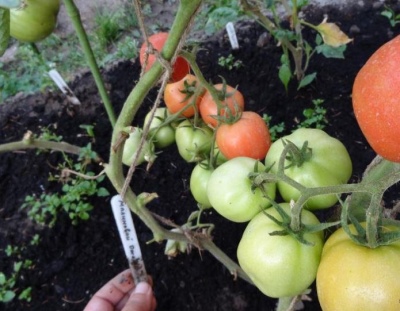
- Category: grade
- Growth type: indeterminate
- Appointment: fresh consumption, for pickling and preserving, for juice, for ketchup and tomato paste
- Ripening period: mid-early
- Ripening time, days: 98-108
- Growing conditions: for open ground, for closed ground
- Marketability: high
- Bush size: tall
- Bush height, cm: up to 200
- Stem: powerful, sprawling
Each variety of tomatoes has its own characteristics. Fruit crop Raspberry Ozharovsky has a stable yield and excellent taste. And also it is easy to look after him. To date, this variety has already been tested by gardeners from different regions of the country.
Description of the variety
In indoor or outdoor conditions, the variety will feel comfortable and will delight with a regular harvest. Growth is indeterminate. The purpose of the varieties is universal. They are suitable for canning, making pasta, juice or ketchup. Fresh, they are also in demand. Tall bushes grow up to two meters. They are powerful and spreading, so they take up a lot of space on the site.
The leaves are outwardly similar to potato seedlings. They are large and have a deep green color. One plant forms 8 to 10 fruit clusters. In each of them, 10-13 ovaries are formed, sometimes their number reaches 15. The largest vegetables ripen on the lower shoots.
In the southern regions, as well as in areas with temperate and warm climates, tomatoes are grown outdoors. In the northern strip, they are grown in greenhouses.
The main qualities of the fruit
Fully ripe tomatoes are evenly colored in a bright raspberry color. The sizes are large, in weight they gain from 100 to 300 grams. The shape is slightly elongated, rounded. Sometimes there is slight ribbing. The pulp is very juicy, but not watery, sugary. Tomatoes are covered with a dense and elastic skin, while it is thin and not tough, so it does not interfere with eating fresh vegetables.
A cut reveals seed nests with few seeds. The percentage of dry matter is from 5.5 to 6. The marketability of fruits is high.
Taste characteristics
The taste of ripe tomatoes is intense. Sweet tones predominate. The gastronomic characteristics are emphasized by an appetizing aroma that attracts attention.
Ripening and fruiting
From the day of emergence to harvest, it takes from 98 to 108 days. The ripening period of the variety is medium early. Bushes bear fruit for a long time.
Yield
The yield indicator is high. One bush forms up to 5 kilograms of vegetables. And about 10 to 14 kilograms of vegetables are harvested from a square meter. Such indicators can be achieved only with proper care of the bushes.
The timing of planting seedlings and planting in the ground
Most gardeners prefer to grow seedlings on their own. So you can be completely sure of its quality and that the bushes of the required variety will grow from the seed used. Sowing seeds for seedlings is carried out in 1-2 ten days of March. By the time the seedlings are transferred to the garden bed, the sprouts will get stronger and form into full-fledged bushes. It is advisable to process the seed with a growth stimulator. This composition will provide the best germination.
And also use a special soil mixture. You can easily find a suitable soil in a gardening store or prepare it yourself by mixing the garden soil with humus.The seeds are deepened into the ground by a maximum of 2 centimeters, sprayed with standing water at room temperature and transferred to a warm place. The pick is carried out immediately after the appearance of two full-fledged leaves. For fertilization, liquid complex fertilizing is used.
Before growing seedlings, you need to take care of the following:
hardening;
additional lighting;
loosening the soil;
airing.

Growing tomato seedlings is an extremely important process, because it largely depends on whether the gardener will be able to harvest at all. All aspects must be taken into account, from seedbed preparation to planting in the ground.
Landing scheme
Up to 4 bushes are placed on one meter of the bed. Plants will feel comfortable and will delight you with a high-quality harvest.

Growing and care
They take care of the bushes according to the following scheme.
Plants are formed into two trunks.
Irrigation is carried out 2 times a week. One bush consumes from 8 to 10 liters of water. The volume of the liquid is selected depending on the weather conditions. In hot summer, plants are watered more often than usual.
Tomatoes are fertilized with phosphorus-potassium compounds, as well as organic matter (mullein or dung).
If weeds appear on the garden bed, they are immediately removed.
The top layer of soil is loosened so that a rough crust does not form on the surface. And also such manipulations are needed for oxygen metabolism, which is necessary for the roots.
Tall bushes are tied to supports. The work is carried out as they grow.
To prevent the bushes from getting sick and not suffering from various ailments, the following preventive measures should be taken:
the soil is mulched, the layer thickness is 8-10 centimeters;
greenhouses are regularly ventilated;
watering and temperature conditions in greenhouses are controlled;
the soil is treated with preparations with copper or potassium permanganate.




A plant needs different micronutrients at each stage of growth. All fertilizers can be divided into two groups: mineral and organic. Folk remedies are often used: iodine, yeast, bird droppings, eggshells.
It is important to observe the rate and period of feeding. This also applies to folk remedies and organic fertilizers.
Disease and pest resistance
Raspberry Ozharovsky is highly resistant to common diseases. The variety rarely affects tobacco mosaic and fusarium. Bushes need to be carefully examined for ailments. To protect the plantation from insects, plants are treated with a solution based on herbs (celandine, chamomile and others) and other folk remedies.



























































































